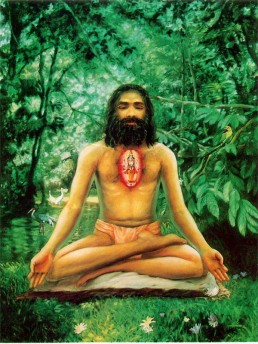Swami Chinmayananda Commentary
The most practical-minded Aryan that he was, Arjuna, the man of action, could not at all be moved merely by the poetic beauty of an ideology. He was thirsty to live, and therefore, the philosophy of meditation and successful victory over the cravings of the flesh could not charm him away to any idle intellectual pursuit. He shot some very relevant questions to explode the seemingly impractical philosophy that had been explained in this chapter.
‘DETACHMENT FROM PAIN-ATTACHMENTS’ (Duhkhah-samyoga-viyoga) was the definition of “Yoga” that Krishna provided in this chapter. The process of achieving success in this “detachment-Yoga” has been explained herein as the technique of withdrawing the mind from the objects by lifting it to the planes of higher contemplation. The theory is that mind, when it comes to a single-pointed devotion in the contemplation of the Self, becomes stilled and redeems itself by ending its ego-centric pilgrimage through the ignorance of Truth, and the consequent mis-judgement of the world.
The goal pointed out — perfect equanimity in all conditions, challenges, and circumstances of life — is an admirable gain, but the technique seems to Arjuna to be sheer poetic fantasy, with no roots in the soil of the actualities of life. The acute intellect of Arjuna, systematically approaching the Science of Self-realisation, discovers as it were, a dangerous missing-link in the chain of its arguments. Mercilessly, the man-of-war is hammering at this weak point, with the absolute confidence that he will immediately expose the hollowness of Krishna’s philosophy.
Thus, Arjuna tauntingly points out: “THIS YOGA WHICH YOU HAVE BEEN TEACHING ME, WITH SUCH MENTAL TRANQUILLITY, IS NOT AT ALL PRACTICABLE.” The argument given out by Arjuna and the daring with which he directly faces his teacher, show the characteristic spirit of a true student of Vedanta. Blind faith can gain no entry into the fields of pure spirituality. The teachers are to answer and clear all the doubts of the seekers. But, in questioning the philosophy expounded by a teacher, the student must indicate the logical arguments by which he had come to feel the particular weakness in that philosophy. Here, Arjuna gives all his arguments, to show why the state of evenness of mind would remain only a dream, as long as the human mind was, by its very nature, ‘restless’ in its own agitations.
In contradicting the Krishna-philosophy, Arjuna is extremely careful. He does not say that mental equanimity cannot at all be gained through meditation, but his doubt is, that it cannot be an experience of “LONG ENDURANCE.” The implication is that, even if after years of practice the mind were to be won over, the experience of the Self can only be momentary, and although a full ‘experience’ of the Infinite can be had in that split-moment, that direct realisation could not be maintained by the Man of Knowledge for any length of time, the mind, being by its very nature, ever restless.
AS IF MAKING HIMSELF MORE CLEAR TO HIS TEACHER, ARJUNA ADDS THE FOLLOWING STANZA WHICH, IN FACT, TAKES THE EDGE OFF FROM THE SPEARHEAD OF HIS LOGIC IN THE PREVIOUS STANZA:
Adi Sankara Commentary
O Madhusudana, ayam, this; yogah, Yoga; yah proktah, that has been spoken of; tvaya, by You; samyena, as sameness; na pasyami, I do not see, I cannot conceive;-what?-etasya, its; sthiram, steady, undisturbed; sthitim, continuance; cancalatvat, owing to the unsteadiness of the mind, which is well known.
The Bhagavad Gita with the commentary of Sri Sankaracharya – Translated by Alladi Mahadeva Sastry
Holy Geeta – Commentary by Swami Chinmayananda
The Bhagavad Gita by Eknath Easwaran – Best selling translation of the Bhagavad Gita
The Bhagavad Gita – Translation and Commentary by Swami Sivananda
Bhagavad Gita – Translation and Commentary by Bhaktivedanta Swami Prabupadha
Srimad Bhagavad Gita Chapter 6 – Verse 33 – 6.33 yo’yam yogastvaya – All Bhagavad Gita (Geeta) Verses in Sanskrit, English, Transliteration, Word Meaning, Translation, Audio, Shankara Bhashya, Adi Sankaracharya Commentary and Links to Videos by Swami Chinmayananda and others – 6-33

